Reverse-Draw Crossbow vs Regular Crossbow
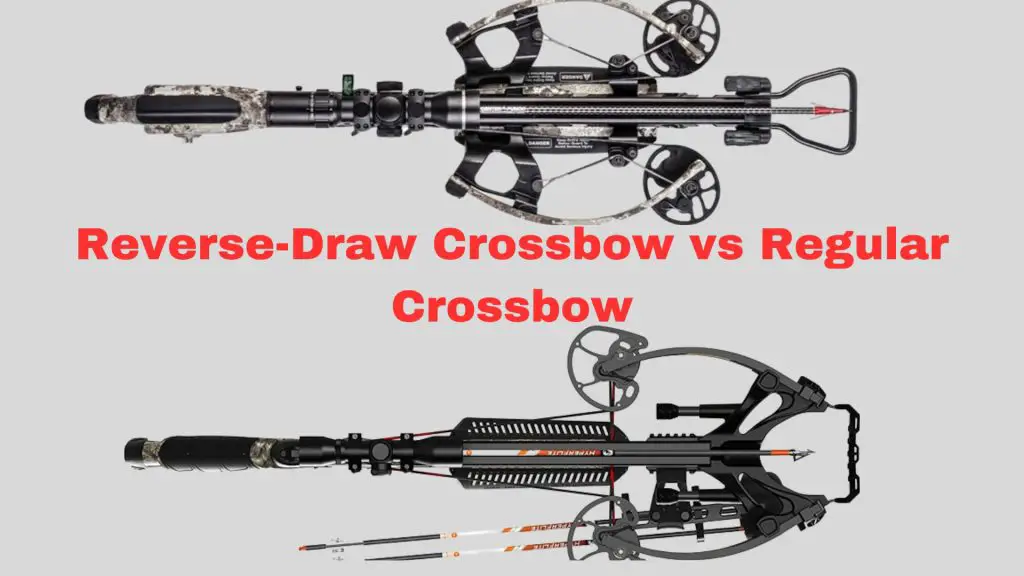
Crossbows are a popular choice for hunting, target shooting, and even self-defense.
They come in different shapes and sizes, with various features that can impact their performance.
One of the most significant differences between crossbows is their draw weight, but another factor to consider is the bow’s design.
Reverse-draw crossbows and regular crossbows are two of the most common designs.
While they may look similar at first glance, they differ in how their limbs are positioned in relation to the riser.
In this article, we will explore the differences between these two types of crossbows, and their respective advantages and disadvantages.
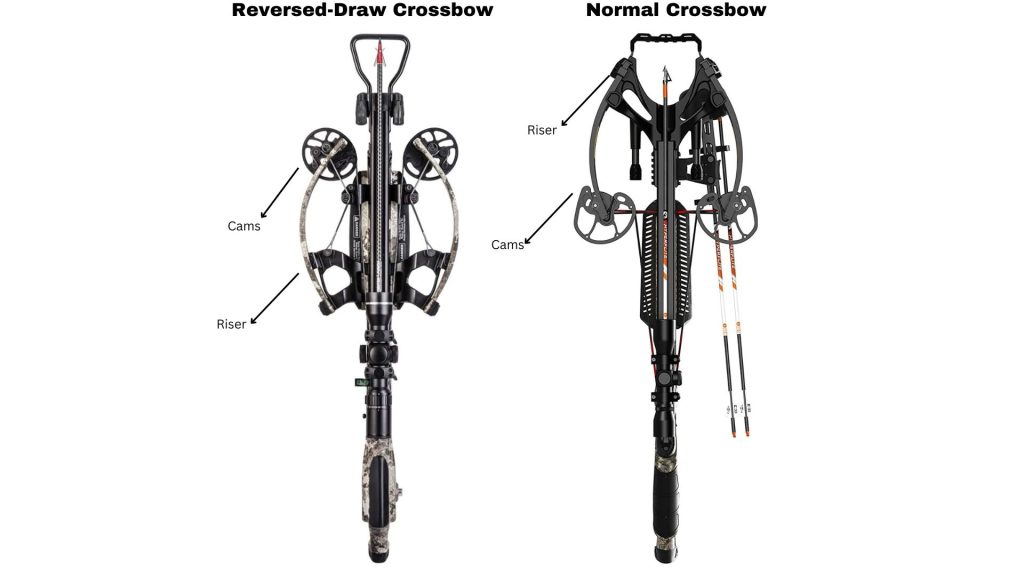
What is a Regular Crossbow?
A regular crossbow is a traditional crossbow design where the limbs or prod are located on the front of the crossbow.
The limbs of a regular crossbow are usually made of composite materials or a single piece of wood.
These limbs are bent back and held in place by a string. The string is drawn back manually, using the shooter’s strength, to create tension in the limbs. This tension is then released when the trigger is pulled, propelling the arrow forward.
A regular crossbow typically has a shorter power stroke than a reverse-draw crossbow, meaning the distance the string travels from a cocked position to a fired position is shorter.
This can result in a lower arrow velocity, but a regular crossbow can still be a powerful weapon, with draw weights ranging from 80 to 200 pounds.
One advantage of a regular crossbow is its simplicity. It is easy to use and maintain and can be fired from a variety of shooting positions, including from a rest or in a standing position.
Regular crossbows are also generally less expensive than reverse-draw crossbows, making them a more accessible option for beginner or casual shooters.
However, a regular crossbow can be more front-heavy than a reverse-draw crossbow, which can make it more difficult to handle and aim, especially for shooters with less upper body strength.
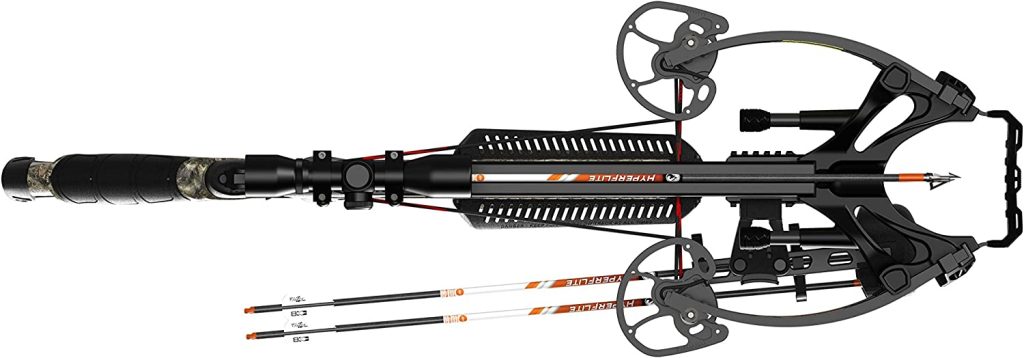
Regular crossbows can also produce more noise and vibration upon firing, which can affect accuracy and potentially spook game during a hunt.
Overall, a regular crossbow is a tried-and-true design that has been used for centuries, and it remains a popular choice for many hunters and target shooters.
Check:
What is a Reverse-Draw Crossbow?
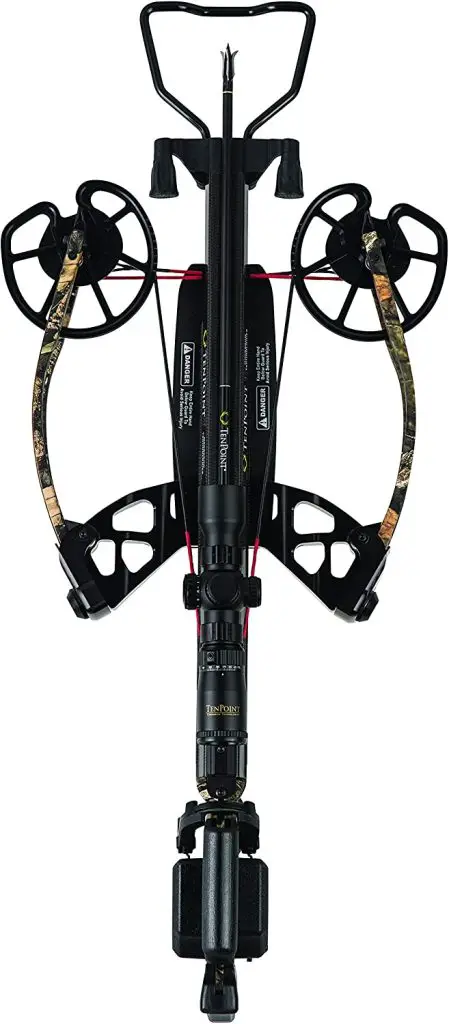
A reverse-draw crossbow, also known as a reverse limb crossbow, is a type of crossbow that has its limbs facing away from the shooter.
In a regular crossbow, the limbs face towards the shooter.
The design of a reverse-draw crossbow is unique in that the riser, which is the central part of the crossbow, is positioned in the middle of the bow, and the limbs extend back towards the trigger assembly.
A reverse-draw crossbow also typically has a longer power stroke than a regular crossbow.
The power stroke is the distance the bowstring travels from its cocked position to its released position.
With a longer power stroke, a reverse-draw crossbow can generate more speed and kinetic energy than a regular crossbow with the same draw weight.
Reverse-Draw vs Regular Crossbow: Comparison
When it comes to comparing the two types of crossbows, there are several factors to consider.
Here are some of the main differences between reverse-draw and regular crossbows:
Design Considerations
One of the most significant differences between a reverse-draw crossbow and a regular crossbow is their design.
A regular crossbow is designed with the traditional crossbow configuration where the limbs are attached at the front of the riser and extended backwards.
In contrast, a reverse-draw crossbow has a unique design where the limbs are attached at the back of the riser and extend forward.
The reverse-draw configuration creates a more compact and streamlined crossbow design, making it more comfortable to handle and shoot.
The overall weight of the crossbow is better balanced with the center of gravity closer to the shooter’s body.
The reverse-draw design also enables the crossbow to be shorter in length than a traditional crossbow, making it easier to maneuver in tight spaces such as dense woods or small hunting blinds.
Additionally, the reverse-draw design provides more room for the string to travel down the rail before releasing the bolt. This additional distance allows the crossbow to have a longer power stroke, which results in faster arrow speeds and higher kinetic energy.
Check: Do crossbow bolts spin
The reverse-draw crossbow’s design also reduces the vibration and noise produced during firing, making it a more comfortable and quieter option for hunting or target shooting.
On the other hand, regular crossbows tend to have a longer power stroke, which may provide a better balance of speed and accuracy.
However, the traditional design may make them more cumbersome to handle and shoot, especially for beginners or those with smaller frames.
Ease Of Carrying: Size and Weight
Generally, reverse-draw crossbows are considered more compact and easier to carry around than regular crossbows. This is because the reverse-draw design places the limbs in front of the riser, which results in a shorter overall length of the crossbow.
Additionally, the weight of a crossbow is a significant factor when it comes to portability.
Many reverse-draw models feature lighter-weight designs than traditional models. This is because the reverse-draw design helps to distribute weight more evenly across the crossbow, resulting in a more balanced and comfortable feel when carrying it.
However, it’s important to note that not all reverse-draw crossbows are necessarily easier to carry than all regular crossbows.
Some regular crossbows may have compact designs and lightweight constructions, while some reverse-draw crossbows may be bulkier and heavier due to additional features such as a larger scope or heavier materials used in the construction.
Ultimately, the ease of carrying a crossbow will depend on the specific model and its design features.
Balance
Reverse-draw crossbows have a more balanced feel due to their center of gravity being closer to the shooter.
Regular crossbows tend to have a front-heavy feel, which can be tiring to hold for extended periods of time.
Accuracy
Both types of crossbows can be accurate when properly adjusted and used with good technique. However, reverse-draw crossbows are generally considered to be more accurate due to their design.
The limbs are placed closer to the shooter’s body, which reduces the torque and improves stability during the shot.
Noise and Vibration
Reverse-draw crossbows tend to be quieter and have less vibration than regular crossbows.
Compared to forward-draw crossbows, reverse-draw crossbows have a longer power stroke, which allows for a lower draw weight to be used while still achieving higher arrow speeds.
This results in less energy to be absorbed by the crossbow parts after the arrow has left the flight rail, resulting in less vibration and a quieter shot.
Check: How Loud Are Crossbows & How To Make It Quieter
Power and Speed
Both types of crossbows can be powerful and fast, but reverse-draw crossbows tend to be more efficient at transferring energy to the arrow.
This means that they can achieve high arrow speeds with a lower draw weight than regular crossbows.
According to a comparison test conducted by Outdoor Life, the reverse-draw TenPoint Nitro XRT crossbow achieved a blistering speed of 447 fps with a draw weight of only 225 pounds. In contrast, the regular-draw Barnett Ghost 410 crossbow reached a speed of 401 fps with a draw weight of 185 pounds.
Another study conducted by Petersen’s Bowhunting found that the reverse-draw Scorpyd Aculeus crossbow was able to achieve a speed of 460 fps with a draw weight of 180 pounds, while the regular-draw Excalibur Micro 360 TD crossbow reached a speed of 352 fps with a draw weight of 280 pounds.
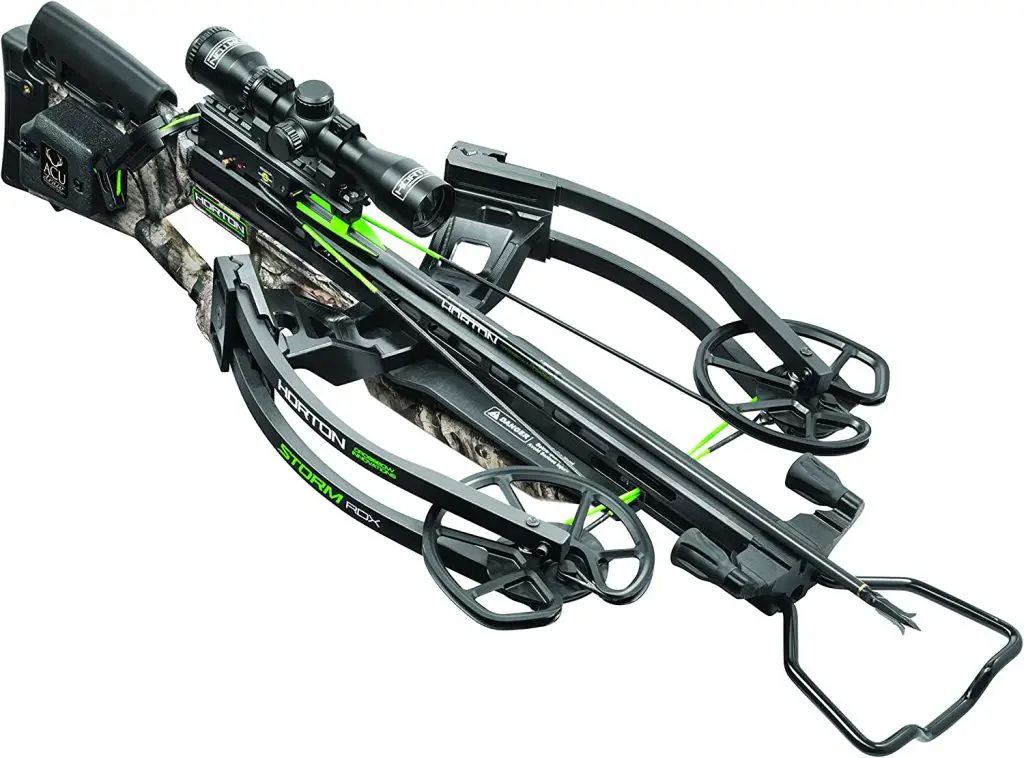
Price Comparison
Reverse-draw crossbows are typically more expensive than regular crossbows due to their unique design and technology.
For example, the TenPoint Nitro XRT, a popular reverse-draw crossbow, has a retail price of around $2,300. The TenPoint Vapor RS470, another popular reverse-draw crossbow, has a retail price of around $3,999.
Regular crossbows, on the other hand, tend to be more affordable.
For example, the Barnett Whitetail Hunter STR, a popular regular crossbow, has a retail price of around $400. The CenterPoint Sniper 370, another popular regular crossbow, has a retail price of around $350.
Reverse-draw crossbows often require specialized components, such as cams and cables, which can add to the cost.
Additionally, the advanced technology used in reverse-draw crossbows, such as the ability to shoot faster with less draw weight, can also contribute to the higher cost.
How To Find Draw Length To Get Draw Weight
However, many hunters and archers find the investment in a reverse-draw crossbow to be worth it for the improved accuracy, balance, and ease of use.
Conclusion
In conclusion, both reverse-draw crossbows and regular crossbows have their own unique advantages and disadvantages. It ultimately comes down to personal preference and intended use.
Reverse-draw crossbows have a few clear advantages over traditional crossbows, including a more balanced and ergonomic design, less noise and vibration, and a longer power stroke resulting in higher arrow velocities. However, they tend to be more expensive and may require additional maintenance due to their more complex design.
On the other hand, traditional crossbows are generally more affordable and easier to maintain, making them a great choice for beginners. They also tend to be more compact and portable, making them a good option for hunting and target shooting in tight spaces. However, they may produce more noise and vibration than reverse-draw crossbows and may require more effort to cock due to their longer draw length.
Check:
Can You Keep The Crossbow Loaded,
Ultimately, the choice between a reverse-draw crossbow and a regular crossbow depends on the individual’s preferences and needs. It is important to consider factors such as cost, design, noise, power, and accuracy before making a final decision. Whether you’re a seasoned hunter or a beginner, taking the time to research and compare different crossbow types can help you find the perfect fit for your needs.
Resource: Tenpointcrossbow
You might be interested in
